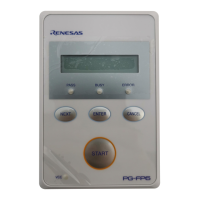PG-FP6 V1.06 2. FP6 Main Unit: Names and Functions of Parts
R20UT4469EJ0800 Rev.8.00 Page 29 of 188
Oct.01.21
(1) Power-supply connector
Connect the power-supply connector to the power adapter for your region. For details on the power-
supply connector specifications, refer to chapter 10, Connectors and Cables.
Note: Do not use a power adapter other than that included with the PG-FP6.
(2) Serial port
Communication is established by connecting the host PC serial port and the FP6 serial port via a serial
cable (RS-232C crossover cable). The data transfer conditions are as follows.
Data transfer speed: 9,600 bps, 19,200 bps, 38,400 bps, 57,600 bps, or 115,200 bps
Data bit: 8 bits
Parity: none
Stop bit: 1 bit
Flow control: hardware
The transfer speed can be changed although it is set to 9,600 bps by default. For details on the serial
connector specifications, refer to chapter 10, Connectors and Cables.
(3) USB connector
Communication is established by connecting the FP6 USB connector (mini-B type) and the host PC USB
port via a USB cable. This connector conforms to USB 2.0 standards. For details on the USB connector
specifications, refer to chapter 10, Connectors and Cables.
(4) Target connector
Connect the target connector to the target system via the target cable. For details on the target connector
specifications, refer to chapter 10, Connectors and Cables.
(5) GND connector
To reinforce the GND, connect the GND connector of the FP6 and the GND of the target system via the
GND cable. For details on the GND connector specifications, refer to chapter 10, Connectors and Cables.
Note: The FP6 and target system may be damaged if there are differences in potential between the
grounds of the FP6 and of the target system. Use the GND cable to eliminate differences in potential
before connecting the target cable.
(6) Remote connector
The FP6 can be remote controlled by connecting the remote connector and an external control device.
For details on remote operation, refer to chapter 6, Usage of the Remote Connector, and chapter 10,
Connectors and Cables.
(7) Power switch
The power switch turns on/off the FP6.
(8) Security slot
This is a security slot for the Kensington lock.

